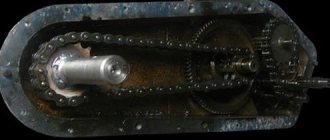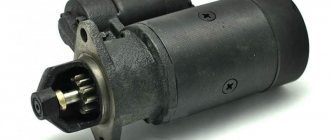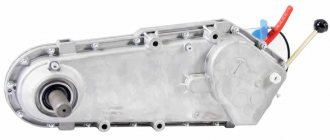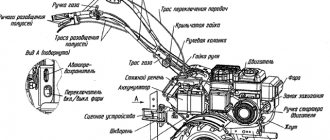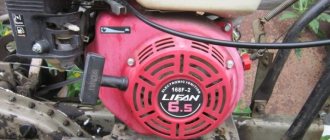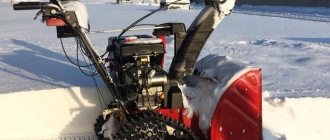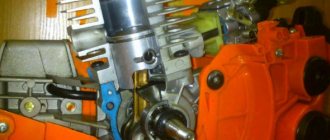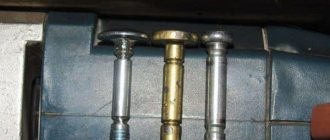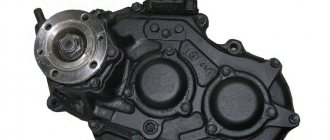After looking at the video of the walk-behind tractor in action, you catch yourself thinking about the need for this purchase. The fact is that tillage is a more serious set of works than it might seem to an inexperienced summer resident. Typically, work with land has a fairly diverse cycle: from the first plowing to harvesting. And all this work can be done not manually, but using excellent mechanized capabilities.
Choosing a Neva walk-behind tractor
Motoblock Luch
The Luch MB 1 walk-behind tractor is used for operation on small household plots, vegetable gardens and gardens for individual use, and again in areas located in swampy areas, shallow forest areas and in suburban areas. This model is produced in Russia and is not very common. Special equipment is suitable for working with light soils.
The Luch MB 1 model is distinguished by its ease of operation and small size. The economical and powerful motor installed in the walk-behind tractor allows it to be used to perform a variety of operations. The model is aggregated with a variety of mounted implements that allow:
- clear and make furrows;
- plow;
- harrow;
- dig up and hill up root crops;
- water;
- spray plants;
- remove snow;
- loosen the soil;
- mow the grass;
- transport goods;
- spray the plants.
Working with Luch MB 1 equipment does not require specialized training. However, each attachment will have to be inspected and studied (the rules of use are described in detail in the operating manual). Otherwise, problems may occur when working with the walk-behind tractor.
In the factory configuration, special equipment comes with cultivators designed for turning and loosening soil, extension cords and specialized wheels. Various modifications of the Luch MB 1 model are distinguished by installed engines, which can be either imported or domestic.
Among the features of the model are:
- ease of operation of the walk-behind tractor. Working with it does not require serious physical effort;
- the presence of a chain reducer with a V-belt drive, ensuring smooth movements of the equipment;
- quick-release wheels and a removable steering wheel make the device very compact and greatly facilitate its transportation;
- the steering wheel is vertically adjustable;
- wheels with pneumatic rubber tires and large tread provide good traction;
- protective fenders installed on the wheels protect against dirt, extending the service life of the equipment;
- reliable transmission with 2 front and 2 reverse gears;
- powerful engines ensure efficient and productive operation of the walk-behind tractor.
Engine characteristics:
- working volume – 0.316 l;
- rated power – 3.7 (5) kW (hp);
- rotation speed – 3200 rpm;
- permissible motor tilt angle – 8 degrees;
- cylinder diameter – 76 mm.
The unit of the Luch MB 1 walk-behind tractor is unpretentious and runs on A-76, A-80 and AI-92 gasoline.
There are certain rules when working with an engine. The manufacturer does not recommend refueling the tank while the engine is running and touching the spark plug bracket or ignition wire.
The Luch MB 1 walk-behind tractor is not very widespread in Russia, so there are relatively few reviews about this technique. However, they are mostly positive. Many owners of the model bought it in a maintained condition, but after that the walk-behind tractor served them for many years without causing any special problems.
The Luch MB 1 model has to be repaired on major holidays. At the same time, special equipment can easily cope with a variety of soil types, which allows you to quickly work out the funds invested in it. The walk-behind tractor works well in tandem with a plow, cultivator and cart. Some owners of the Luch MB 1 machine use it in winter.
Problems with the engine of equipment are extremely rare. The main point here is to control the oil level
It is important that it remains at least below the minimum mark, otherwise the engine will start knocking.
Sometimes problems arise with the tension roller. This element may simply crack. Among the disadvantages of the model, again, is some incompleteness of the design.
The walk-behind tractor works well on difficult soil and near trees. The strength of the structure and excellent maneuverability help with this. As a transporter, Luch MB 1 again copes with its responsibilities with dignity.
The special equipment itself takes up little space, so it is convenient to transport it in a car and store it in a small garage. At the same time, it is indispensable in a small area.
Clutch slippage, which again often occurs in this model, is regulated by shortening the chain.
Cost of new and used
The price tag for the Luch MB 1 walk-behind tractor is not prohibitively high. Currently, it is almost impossible to buy this model without working hours. At the same time, supported options are in active demand. Beam MB 1 in good condition can be purchased for 15,000-17,000 rubles.
Owner reviews
Novel:
“I have had an excellent Soviet walk-behind tractor since time immemorial, left over from the previous owners of the dacha, when they sold the dacha to us, all the equipment with attachments was, as they say, put to work. I had to dig a little into the stuffing, restore the good old MB-1, and it worked like new! I use it for seasonal work; in winter it just sits in storage.
Advantages: powerful, after major repairs it has never caused any problems, it has been in operation for 8 years.
Disadvantages: new models are now expensive to buy, but this is a pretty decent unit, decent, with a good history, I think it will still serve.”
Motor problems
Engines running on different types of fuel (gasoline or diesel) have different service life. For engines using diesel fuel, it is much larger, but it is gasoline units that are popular due to their lower cost and ease of operation and repair.
- startup problems;
- problems with smooth operation.
Problems in the fuel system
The first thing you need to do is check the spark plugs. If they are dry, this may mean that gasoline is not getting to the engine. The main reasons will be: lack of fuel, the supply valve was closed, the hole in the tank plug is clogged, unnecessary objects get into the fuel system.
- refuel the walk-behind tractor;
- unscrew the fuel supply valve;
- clean the gas tank cap;
- remove all gasoline from the tank, having first removed the fuel valve, and wash it with clean fuel. Then blow out the jets in the carburetor using the fuel supply pump.
When the candles are left wet
The following malfunctions are identified:
- The appearance of carbon deposits on the spark plugs. They should be cleaned with a rough surface and washed.
- The gap between the electrodes has been increased or decreased. You need to adjust it to the required size.
- Wiring insulation is damaged. It is usually replaced with a new one.
- There is a ground short to the STOP button.
- The ignition system starter is faulty.
The rubber carburetor seals may also become loose, causing air to be sucked in. It is necessary to tighten the bolts, spark plugs and inspect the gaskets between the cylinder and the spark plug head.
Another option for poor engine starting may be that the carburetor air damper does not close completely.
If the compression is broken, it will also be difficult to start the engine. The reasons are: carbon deposits on the valves, the intake valve is deformed, or the piston rings are already worn out.
Problems during operation usually appear when the engine's node connections, subject to overload, fail, which leads to failures.
When the engine begins to pick up and slow down on its own, this is possible when the traction and the fastening of the levers are weakened. To eliminate this, simply adjust the control drive.
If the engine loses power, it means it has overheated. In this case, the engine may jam, which happens when the oil level in the crankcase is low, a nadir forms on the connecting rod head, or the oil squirter has become unusable.
MOTOR-CULTIVATOR MB-1, MB-75, MB-80 MOTOR-BLOCK MB-105, MB-135, MB-135S. Manual
Transcript
1 Operating manual MOTOR-CULTIVATOR MB-1, MB-75, MB-80 MOTOR-CULTIVATOR MB-105, MB-135, MB-135S Attention!!! Read the instructions before using the product.
2 2
3 INTRODUCTION Dear user! Thank you for purchasing our products. This manual contains the operating rules for KAMA MB series motor-cultivators and walk-behind tractors (hereinafter referred to as the “product”). Please read the manual carefully before starting work. Operate the product in accordance with regulations, safety requirements and common sense. Save the instructions, you can always refer to them if necessary. Due to changes in specifications, the contents of this manual may not fully correspond to the product you purchased. The manufacturer reserves the right to make changes to the design of individual components and parts without prior notice. Keep this in mind when reading the instruction manual. 3
4 1. SAFETY INSTRUCTIONS To ensure safety, please pay attention to the following instructions: KAMA MB series motor-cultivators and walk-behind tractors are designed in such a way that they are safe and reliable in operation when these instructions and recommendations are followed. Please read this manual very carefully before using these products. Improper use of the product may result in product failure or personal injury. Exhaust gases contain toxic substances. It is strictly prohibited to use the product in enclosed spaces. Ensure that work areas have adequate ventilation. The rotating parts are very sharp and reach high speeds during operation. Consequently, accidental contact with these components may cause serious injury. Be extremely careful. When using the product, the worker’s hands and feet should be kept at a safe distance. Before inspecting or servicing the blades, stop the engine and disconnect the blades. 1. During operation, hold the product by both handles when rotating the cutters and/or operating the motor. Remember that the cutters continue to rotate even when you release the throttle. Before placing the product, make sure that the cutters have completely stopped and the motor is turned off. 2. Always stand firmly on the ground, do not lose your balance, and do not reach for the product. Before starting work, look around to see if there are any obstacles in your area that could cause you to trip and cause the product to fall out of your hands. 3. Carefully inspect the area where the unit will be used and remove any objects that it may throw. 4. Be sure to remove children, animals and strangers from the work area. 5. Always be attentive. Evaluate your actions using common sense. Do not operate the product if you are tired. 6. Always dress appropriately for work. Do not wear loose clothing or jewelry as they may get caught in moving parts of the product. Wear strong gloves. Gloves reduce the transmission of vibration to your hands. Prolonged exposure to vibration can cause finger numbness and other illnesses. Wear shoes with non-slip soles for added stability. 7. Do not work with the product barefoot or wearing open sandals. 4
5 8. Always wear safety glasses. To avoid damage to your hearing, it is recommended that you wear hearing protection while operating the product. 9. To reduce the risk of fire, do not allow debris or excess lubricant to accumulate on the engine or in the gas tank area. 10. Start the engine carefully, following the manufacturer's instructions; Make sure that your feet are not located near the working parts. 11. To ensure safe use of the product, ensure that all nuts, bolts and screws are securely tightened. 12. Be especially careful when changing direction or pulling the product towards you. 13. Work only during the day or in good artificial light. 14. When working on slopes, be careful not to slip. 15. Use extreme caution when changing direction on slopes. 16. Always maintain a safe distance from other people who work with you. 17. Always inspect the product before operating to ensure that all handles, fasteners and safety flaps are in working order and in place. 18. Always service and inspect your product carefully. Follow the maintenance instructions in this manual. 19. Always store the product in a locked, dry place out of the reach of children. 20. Do not attempt to clean cutters while they are rotating. First, turn off the motor and wait until the cutters stop completely. 21. Do not allow children or persons incapable of such work to use the product. 22. Do not operate the product while under the influence of alcohol or drugs. 23. Do not attempt to repair the product yourself. To carry out qualified repairs, contact an authorized dealer in your region. 24. Do not refuel the product near open flame sources. Before refueling, stop the engine and make sure it is cool. 5
6 2. TECHNICAL CHARACTERISTICS AND DELIVERY SET Model MB-1 MB-75 MB-80 MB-105 MB-135 MB-135S Dimensions (mm) 1470*580* *950* *1050*800 Net/gross weight (kg) 80 / / / / / / 121 Drive type Belt Clutch Plowing width (mm) Design plowing depth (mm) Mills 3*4 3*4 4*4 4*4 Transmission type -2, -1 (rear), 0, 1 , 2-1 (rear), 0, 1, 2-1 (rear), 0, 1, 2 Engine type single-cylinder, four-stroke, forced air cooling Engine displacement (cm 3 ) Max. engine power, hp Maximum torque Ignition system ,0 9.0 13.0 12/ ,8/ /2500 Transistor magneto Starting system Manual kick starter Product performance is ensured from -5 to +35 C at ambient temperature Fuel tank capacity 3.6 4.0 6.0 6.5 (l) Engine oil capacity (l) 0.6 1.1 Gearbox oil type Gear oil SAE 80W-90 6
7 Delivery set 1. Motor-cultivator / walk-behind tractor.. 1 pc. 2. Instruction manual.. 1 pc. 3. Set of cutters set. 4. Packing pcs. 5. Spare parts kit 6. Wheels 5.00*12 (for models MB-105, MB-135, MB-135S).. 1 pair 3. PRODUCT DESIGN 3.1. DESIGN OF MOTOR CULTIVATOR KAMA MB-1 7
8 Motor cultivator MB-1. Left view (protective cover removed) 1. Drive pulley 2. Forward pulley 3. Forward belt 4. Reverse belt 5. Forward axle 6, 8. Spring 9. Reverse bracket 10. Steering wheel height adjustment bar 11. Link forward 12. Reverse link 13. Forward lever 14. Reverse lever 16. Reducer pulley 17. Axle 18. Pin 19. Bracket 20. Stop 21. Reducer 22. Pin 23. Arc 24. Reverse pulley 25. Lever 8
9 3.2. DESIGN OF MOTORCULTIVATOR KAMA MB-75, MB Engine 2. Starter handle 3. Control handle 4. Clutch lever 5. Coulter 6. Cultivator blade 7. Fuel tank 8. Fuel tank cover 9. Dirt protection 10. Oil filler hole cover 11. Mill assembly 12. Air filter 13. Engine control lever 14. Steering wheel adjustment mechanism 15. Gearbox 16. Engine stop button 9
10 3.3. DESIGN OF MOTOR-BLOCK KAMA MB-105, MB-135, MB-135S 1. Wheel 5.00*12 2. Hexagonal shaft 3. Protective wing 4. Deeper (coulter) 5. Gear shift lever 6. Steering wheel tilt adjuster 7. Reverse cable 8. Reverse handle 9. Steering handles 10. Throttle lever 11. Engine switch 12. Clutch handle 13. Clutch cable 14. Air filter cover 15. Fuel tank cap 16. Fuel tank 17. Starter handle 18. Bumper 19. Lift handle racks 20. Rack 21. Starter housing 22. Gearbox 23. Steering wheel 24. Engine 25. Mill 26. Chassis 10
11 4. PRELIMINARY CHECKING OF THE PRODUCT ATTENTION! THE ENGINE AND GEARBOX ARE SUPPLIED WITHOUT OIL! 4.1. Engine oil level Attention! Running the engine with low oil levels can cause serious damage and malfunction. Unscrew the oil filler cap and thoroughly wipe the dipstick built into it. Measure the oil level by lowering the dipstick into the neck of the oil sump. If the oil level is low, fill the crankcase with the recommended type of oil to the top of the neck. Use 4-stroke air-cooled engine oil or equivalent highly refined oil. SAE 10W-30 grade oil is recommended for use at any temperature. Attention! Using unrefined motor oil or two-stroke engine oil will cause engine failure. ATTENTION! Operating with a low oil level in the engine crankcase or operating without oil will result in engine damage and will not be covered under warranty. Always check the engine oil level before starting work. To check the oil level, the product must be installed on a level surface and the engine turned off. To check the oil level after stopping the running engine, let the engine sit for 4-5 minutes to allow the oil to drain into the crankcase. ATTENTION! The oil level sensor installed in the engine crankcase is designed to provide protection only during start-up. The sensor does not stop a running engine. ATTENTION! When putting a new engine into operation, the first oil change must be done after 5 operating hours, the second change after 25 operating hours. Each subsequent engine oil change after 50 operating hours. eleven
12 (1) (1) oil filling hole (2) upper level (3) lower level 4.2. Transmission oil level in the gearbox ATTENTION! The product is supplied without lubrication in the gearbox. Insufficient oil in the gearbox can cause serious damage. Before starting operation, it is necessary to fill the oil through the filling hole to the required level. For lubrication, use 80W-90 SAE gear oil. It is recommended to change the oil in the gearbox immediately after operating the product, when the oil is warm. After filling the oil, install plugs with gaskets. Oil leakage is not allowed Air filter Attention! A dirty filter will impede the flow of air into the carburetor. To avoid engine malfunctions, regularly clean the filter and inspect the external condition of the filter housing. Do this more often if the engine is operating in dusty areas. Fuel Use at least A-92 motor gasoline (preferably unleaded). Never use dirty gasoline or gasoline containing oil. Avoid getting water, dust or dirt into the fuel tank. Refuel in well-ventilated areas with the engine turned off. 12
13 ATTENTION! Gasoline is flammable and explosive under certain conditions. Filling the fuel tank should be done outdoors or in well-ventilated areas with the engine not running. It is prohibited to smoke or allow open flames or sparkling objects in areas where fuel is refueled or where gasoline containers are stored. Be careful not to spill gasoline when filling the fuel tank. Spilled fuel or fuel vapor may ignite. If you accidentally spill fuel, wipe up any spills or drips before starting the engine. Avoid frequent or prolonged skin contact with gasoline and do not inhale gasoline fumes. ATTENTION! Use unleaded gasoline with an octane rating of at least 92. Never use old, contaminated gasoline or oil-gasoline mixtures. Avoid getting dirt or water into the fuel tank. Engine failure due to the use of low-quality or old fuel, as well as fuel with an inappropriate octane number, is not subject to warranty service. Assembly and installation of cutters We draw your attention to the correct assembly of cutters (see the figure below), especially the correct installation of two shortened knives. Short knives must be installed as shown in the illustration. They are needed so that during operation of the product the cutters do not touch the gearbox of the product with knives. Warning: Incorrect assembly and installation of cutters, in particular incorrect installation of short knives, will lead to product failure. 13
14 5. STARTING AND STOPPING THE ENGINE Depress the clutch and move the gear shift lever to neutral to avoid sudden jerking of the product when starting the engine. The clutch is disengaged by pressing the clutch lever and engaged by releasing the lever. Move the fuel valve to the ON position and check that there is no fuel leakage. (1) fuel tap (2) open position (ON) (3) drain bolt 5.2. Close the throttle (set the lever to the “CLOSE” position). Note: Do not close the choke if the engine is warm or the ambient temperature is high. 14
15 (1) air damper (2) “closed” position (CLOSE) 5.3. Move the engine start switch to the ON position. Move the throttle control to the full throttle position. Pull the starter handle smoothly until you feel resistance, then return it to its original position and pull the handle sharply towards you. ATTENTION! Before each engine start, be sure to check the oil level in the crankcase. ATTENTION! When starting a warm engine, do not close the choke, otherwise you will flood the spark plug. ATTENTION! Always strictly follow clause 5.5. to avoid dynamic shock to starter parts and starter damage. Do not release the starter handle abruptly from the top position, otherwise the cord will wrap around the flywheel and damage the starter. Release the handle slowly to avoid damaging the starter. Failure to comply with these instructions often leads to starter failure and is not subject to warranty service. (1) starting handle 15
16 5.6. As the engine warms up, gradually move the choke lever to the OPEN position. (1) choke lever (2) “open” position (OPEN) 5.7. When turning off the engine, perform the following procedures in sequence: — Turn the throttle knob to the “OFF” position; — Set the engine switch to the “OFF” position; — Move the fuel tap to the “OFF” position; — Press the engine switch off button. 6. OPERATING PROCEDURE 6.1. Adjusting the plowing depth Place the attachment into the accessory and secure it with the accessory rod. Adjustment of plowing depth can be achieved as follows: Remove the auxiliary rod and locking pin, loosen the bolt in the auxiliary device, move the auxiliary device to the side, and remove it if necessary. (1) auxiliary device (2) auxiliary device rod (3) locking pin (4) opener (5) pin 16
17 6.2. Shifting gears Return the throttle lever to the idle position. Squeeze the clutch lever to disengage the clutch. Move the gear shift lever to the desired position. Reverse gear for motor cultivators MB-1, MB-75, MB-80 is engaged in the same way. To engage reverse gear on walk-behind tractors MB-105, MB-135, MB-135S, you need to squeeze the clutch handle and move the gear shift lever to position 0 (N, neutral). Press the reverse handle Angle of control of the product during plowing Lightly press the control handles so that the front of the product is raised by 6-8. In order to obtain the best performance of the product, it is necessary to operate it as shown in the figure. 17
18 7. PRODUCT MAINTENANCE Warning. Turn off the engine before performing maintenance. Product Maintenance Chart Engine Oil Check Level Internal Element Check Air Filter Fuel Filter O-Ring Spark Plug Transmission Oil Valve Stem-Pushrod Clearance Fuel Tank and Fuel Filter Every Time Started O First month or 20 hours of operation Every 3 months or every other 50 operating hours Every 6 months or 100 operating hours Replace OOO Clean O (1) Clean O Clean. Adjust Check level Clean. Adjust OO After 1 year or 300 hours OO (2) Clean O (2) Clutch cable Adjust OO Throttle cable Adjust Belt tension Adjust OOO Fuel line Check Every two years (2) (Replace if necessary) Note. (1) Carry out more frequent inspection and maintenance if the product is used in dusty places. (2) these actions must be carried out by an authorized dealer, since the workers do not have the appropriate tools and experience. 7.1.Changing engine oil It is necessary to drain the oil when the engine has not yet cooled down in order to completely and quickly drain the oil. Remove the oil filler cap and drain the oil. Fill with the recommended oil and check its level. 18
19 (1) oil drain plug (2) oil filler cap (3) upper limit level Note. Please dispose of engine oil in accordance with the fuel and lubricants disposal rules and do not pollute the environment. Do not dump used oil on the ground. Air Filter Maintenance A dirty air filter can prevent air from flowing into the carburetor. To prevent carburetor malfunctions, clean and inspect the air filter housing regularly. Warning. Never use gasoline or thinner to clean the air filter. There is a risk of fire. Note: Never operate the product without an air filter as this may cause excessive engine wear. Spark Plug Maintenance Warning! Never use candles of a different heat setting. The muffler becomes very hot when the engine is running. Avoid contact with the muffler. For the engine to work properly, the spark plug must be installed with the correct gap and there must be no deposits on it. Remove the tip of the high-voltage wire from the spark plug and unscrew it using a spark plug wrench. Inspect the spark plug. Replace it if the insulator is cracked or broken. Measure the spark plug gap with a gap gauge. Adjust the distance by bending the side electrode. The gap should be: 0.70 0.80 mm. Place the washer on the spark plug and tighten it in such a way as to avoid screwing it skewed. 19
20 Tighten the spark plug with a wrench to compress the washer. Note: When installing a new spark plug, tighten the washer an additional 1/2 turn to press it down. If you are installing a spark plug that you have previously used, tighten it 1/8 1/4 turn. Note. The spark plug must be properly torqued. A plug that is not fully tightened can become very hot and damage the engine. Clutch cable adjustment Measure the free play of the clutch at the end of the lever. The free play should be 3-8 mm. If the clutch cable travel is not correct, loosen the lock nut and tighten or unscrew the adjusting bolt as necessary. After adjustment, tighten the lock nut appropriately. Then start the engine and check the clutch operation. Adjusting the throttle cable Measure the free play of the clutch cable at the end of the lever. The free play should be 5-10 mm. If the free play is not correct, loosen the lock nut and turn the adjusting nut as necessary. (1) throttle lever (2) adjusting nut (3) lock nut 20
21 8. TRANSPORTATION AND STORAGE OF THE PRODUCT Caution. When transporting, turn off the fuel valve (OFF position) and keep the engine in a horizontal position to avoid fuel leakage. Gasoline vapors or leaked fuel may ignite. Before storing the engine: 8.1. Make sure that the storage area for the product is free from dampness and dust. Drain the fuel. Warning. Under certain conditions, gasoline is extremely flammable and explosive. Do not smoke or allow sparks or flames to occur in the work area. — With the fuel valve turned to the OFF position, remove and empty the sump. — Turn the fuel valve to the “ON” position and pour gasoline from the fuel tank into a suitable container. — Reinstall the sump and tighten it thoroughly. Change the engine oil. Remove the spark plug and pour a tablespoon of clean engine oil into the cylinder. (1) O-ring (2) fuel filter (3) drain bolt 8.5. Crank the engine several times using the recoil starter to distribute the oil evenly, then install the spark plug. Pull the starter belt slowly until you feel resistance. Cover the engine to protect it from dust. 9. TROUBLESHOOTING AND WAYS TO ELIMINATE THEM The engine does not start: Check if the switch is in the “ON” position? Is there enough oil in the engine? Is the fuel valve open (ON position)? Is there gasoline in the fuel tank? Is gasoline getting to the carburetor? 21
22 To check this, loosen the drain bolt with the fuel valve open. (1) fuel cock (2) ON position (3) drain bolt Is there spark at the spark plug? — Remove the cap from the candle. Remove any dirt from around the spark plug, then unscrew the spark plug. — Check the spark using a special device. — If there is no spark, replace the spark plug. — If everything is fine, reinstall the spark plug and try to start the engine again according to the instructions. If the engine still does not start, take it to an authorized dealer. 10. WARRANTY The warranty period for the product is 12 (twelve) months from the date of sale. Warranty obligations apply only to cases of defects in the manufacture and assembly of the product or its individual parts made of substandard materials and/or violations of the technology of their manufacture and assembly. 1. The product is not subject to warranty service in the following cases: - preliminary repair of the product by the user or an unauthorized person; — presence of traces of opening or attempted opening; — violation of the operating instructions; — making changes to the product design; — mechanical damage to the product due to improper transportation and storage, careless handling, falling, impacts, etc. d. - natural wear and tear of the product and components as a result of intensive use; — use of non-original spare parts and accessories. 2. Warranty service is not provided if: - there is no warranty card; — the warranty card is not genuine or not properly executed (no sale date, serial number, signatures of the seller and buyer, store stamp); — 22
23 - the warranty card does not belong to this product; - upon expiration of the warranty period. 3. Warranty service does not apply to the following wearing parts and consumables: spark plugs, air filters, fuel filters, ignition switches, wheels, belts, pressure rollers, pulleys, etc. 4. Before starting operation, carefully read the requirements of the operating instructions . 5. When submitting the product for warranty repair, you must have the packaging for the used engine oil. 6. The subject of the warranty is not the incompleteness of the product, which could be discovered during the sale of the product. 7. The product is accepted for warranty repair in its pure form. 8. Natural wear and tear of the product and its components as a result of intensive use is detected by diagnostics at an authorized service center. I have read the operating instructions, technical characteristics of the product, and warranty terms. Pre-sale inspection has been completed. I have no complaints about the appearance or configuration of the product, and I also confirm the acceptability of the warranty conditions. Buyer's signature SERVICE CENTER ADDRESS: , Russia, Perm, st. Levchenko, 1 tel./fax: (342) Made in China 23
24 24
25 Milling cutter assembly drawing 25
26 26
27 27
Review of the Luch MB-1 walk-behind tractor: revealing the essence
Agricultural mechanization serves as the main direction of development of the agricultural policy of any state. For mechanized tillage, the Luch MB-1 walk-behind tractor is very popular.
The unit is a prominent representative of reliable and durable Soviet-made equipment. To perform various tasks, the unit is equipped with additional tools.
Description
Luch walk-behind tractors have come a long way from their creation to the present day. Initially, the manufacturer of these walk-behind tractors was the Perm Motors OJSC enterprise, which in the 90s became part of the Perm engine-building complex.
The units are well-deservedly popular among domestic farmers and have a reputation as powerful, productive, fault-resistant devices with varying capacities. Each owner can choose a walk-behind tractor model based on the site, scope of work, and purpose.
Photo of the Luch MB-1 walk-behind tractor
Features of the Luch walk-behind tractors are as follows:
- affordable price and high build quality;
- attachments suitable for many other domestic and Chinese models;
- endurance, possibility of use in any season;
- ability to work on any type of fuel (gasoline AI-92, AI-76, AI-82 and other types of gasoline);
- almost complete absence of bad reviews about walk-behind tractors (among the positive reviews there are many mentions of endurance, good assembly, reliability and power of the device).
: Review of the characteristics of the Lifan walk-behind tractor: we explain in detail
Manufacturers and production history of "Luch MB-1"
The first production model of the Soviet walk-behind tractor rolled off the assembly line of the Perm production association “Motorostroitel” named after Ya. M. Sverdlov” in 1985.
During the production of the walk-behind tractor, a large number of modifications of this equipment appeared. The main difference between each of them is the power plant and attachments produced by Russian and foreign manufacturers.
Since 1991, the unit has been produced by the joint-stock company Kaluga Engine (JSC CADVI). From 2011 to the present day, the equipment is produced under the name “Oka”.
Motoblock Luch MB-1
Design of the Luch MB-1 walk-behind tractor
The main components of the device are:
- Power unit.
- Gearbox.
- Clutch.
- Control system.
- Chassis.
Design of the Luch MB-1 walk-behind tractor
Clutch block
The system is designed to transfer rotation from the engine crankshaft to the gear sprockets. Allows you to move forward and backward. The clutch is controlled by a lever on the handle.
Motoblock clutch Luch MB-1
Control system
Designed to change the modes of action, speed and direction of movement of a mechanical device. Consists of a steering wheel, control levers and gear shift knob.
A motor control lever is installed on the right handle of the steering wheel. The left handle has gear shift levers. The steering wheel height is adjusted using a nut connection.
Walk-behind tractor control levers
Chassis
Wheels or a cultivator are installed as elements of the Luch MB-1 chassis. Wheels can be pneumatic or solid rubber. They are designed to move the mechanism on a flat surface. For better traction, stamped steel wheels (lugs) are used.
A cultivator is used to loosen the soil and remove weeds. The device is equipped with two tillers and two cultivators based on a bolted connection. Installed on the output shaft of the gearbox instead of wheels.
Milling cutter for walk-behind tractor
Available Luch models - engine types, power
The model range of Luch walk-behind tractors is represented by the following positions:
- Luch MB-1 (power 5 hp, Kadvi 168F-2A engine);
- Luch MB 5040 (a series of walk-behind tractors with engines DM51, 52, 53 and 54, had an easy start function and a forced lubrication system, the power of walk-behind tractors in this series was 5 hp, in fact 5040 was a more advanced version of MB-1);
- Luch MB 5141 (engine DM51, power 5 hp, a model that has not become popular, is now represented mainly by used models, new walk-behind tractors of this series are not produced).
Of all the indicated representatives of a number of walk-behind tractors, only the “Luch” MB-1 is produced for mass consumption.
The design features of the Luch walk-behind tractors are generally similar, the units are similar to each other, in different series the shape of the fuel tank can only change, for example, in the MB 5040 the tank is square, located closer to the engine.
Motoblock "Luch" MB 5040
Reviews about the main features of the walk-behind tractor
The above-mentioned walk-behind tractor has been produced since 1984. During this time, the technology managed to win the trust of many consumers. Over time, the unit has been improved and modernized, but you can still find working copies from the 90s. The manufacturer is in the city of St. Petersburg. The company specializes in the production of motorcycle and agricultural machinery.
Consumers emphasize that the MB-1 walk-behind tractor is constantly being modernized and is popular among buyers, as it has been time-tested. Over time, this equipment was equipped with a new gearbox with an increased number of gears, which is very popular with land owners. The technique provides three variable gears and one reverse gear. If you change the belt to a double belt pulley, you can get another set of gears.
What types of work does the Luch walk-behind tractor perform?
According to user reviews, attachments allow you to perform the following types of work using a walk-behind tractor:
- cleaning sidewalks and paths from dirt, dust, snow, leaves;
- mowing grass to later prepare it for hay;
- drilling holes, etc.;
- transportation of goods;
- plowing and harrowing the land;
- cleaning and forming furrows;
- digging and hilling plants;
- watering;
- harvest.
To carry out this type of work, you do not need any special knowledge or skills. You just need to carefully read the user manual, which is sold along with the walk-behind tractor.
Let's consider the advantages of a walk-behind tractor. The device for agricultural work is sold in different configurations and modifications, each of which has many advantages. The general positive features of the multicultivator include:
- Chain gearbox of the MB walk-behind tractor with wedge transmission, which significantly improves the cross-country ability and speed of the MB walk-behind tractor.
- The presence of a belt.
- The walk-behind tractor is very easy to operate; the unit moves smoothly when turning and does not make sudden movements.
- The mechanism has wheels and a steering control - a movement regulator. The steering wheel of the device is removable, so it can easily be installed on another model.
- You can put pneumatic rubber tires on the walk-behind tractor that have a deep tread. Thanks to this, the mechanism moves smoothly over gravel and textured surfaces. Tires are sold complete with other spare parts and components.
- The steering wheel can be adjusted vertically.
- There are special fenders on the wheels, which are designed to protect the wheels from dirt and earth, so the unit can be used in fields under different weather conditions.
- The motor in the MB-1 Luch is very powerful, allowing you to perform many types of work on a summer cottage or field.
- The mechanism has a durable transmission, which has 2 forward and 2 reverse gears.
- Gasoline carburetor, which ensures economical consumption of gasoline.
Thus, the MB-1 Luch and MB 5040 walk-behind tractors will perfectly cope with tasks in the country and in swampy areas. The cultivator will not stall at the right moment because it consumes a small amount of fuel. The user must carefully monitor the oil level so that the engine does not knock or make other sounds. The device is also used to cultivate the soil near trees. These areas always cause difficulty when digging or planting.
In winter, the unit will not sit idle in a storage room or barn, since it is often used for removing snow and transporting goods, including dug up root crops.
Instructions for use, maintenance, basic faults and repairs
The instructions for the Luch walk-behind tractor are an important document, according to which you need to use this unit, start it, run it in, and change the oil. If you wish, you can find instructions online in electronic form. Let's take a closer look at the main points of maintenance and operation of the walk-behind tractor.
Oil and fuel
The performance characteristics of a walk-behind tractor depend, first of all, on the quality of the fuel and oil. The main advantage of "Luch" is that it works on any gasoline, from AI-76 to AI-95. Any gasoline can be poured into the gas tank. What is the best oil to use and when to change it? Oil changes are carried out as standard - once every 50-100 engine hours, depending on the degree of load on the walk-behind tractor.
- Type of oil: M-12 GI, M-10 GI, TU 38.10148-85.
- The type of spark plug for the Luch walk-behind tractor is A17B or A11-1.
First launch and run-in
The first start of the walk-behind tractor is allowed if the device is in a fully assembled state, with the gas tank filled. From the moment you turn it on for the first time until 20 hours later, the walk-behind tractor runs in. At this time, the gearbox and motor adapt to the load. After the break-in period has expired, you can use the equipment at full power and maximum loads.
Alterations
The Luch walk-behind tractor is a fairly old piece of equipment, so all its modifications are quite reasonable. In addition, it is now quite difficult to find a new unit, so all walk-behind tractors presented for open sale have already been in use for a certain time.
The MTZ-82 model tractor can be called the real pride of the post-Soviet industry. Here are all its advantages and technical characteristics.
ZIL-130 is the most common Soviet-era truck manufactured. Zil 130 is a highly functional, fast and quite comfortable development for its time period.
Previously, the process of cultivating the land was really long and difficult, because the farmer's tools were not as effective as they are now. Here is everything about the different models of the PSK plow.
As for some improvements, we can highlight several examples of useful, in our opinion, alterations:
- The first thing you can try to replace is the front drive belt tensioner pulley. The fact is that the standard roller is quite noisy during operation, especially after long-term use.
- The reason for this is that the bearing grease has dried out, and it is not possible to replace it with a new one, because its sides are flared.
- As a replacement, you can use a pulley from the timing belt of a VAZ 2112 car (or similar). On both sides of the roller there are two springs - one is the main one, leading to the control lever, and the second pulls the roller back.
- You can also weld a new muffler. What we have left from the old one is a cast iron elbow, which is quite problematic to weld anything onto. This problem can be solved by simply turning to lathes, who will turn out a thread into which a steel corner can be welded.
- The muffler can was taken from the PD 10 engine, which is located at the very end of its exhaust pipe. The same corner that was used at the base of the homemade muffler is welded to the top of the can.
- The engine breather also requires certain changes. The fact is that the standard breather runs in one straight line, connecting to the air cleaner with a fairly short hose.
- During operation, it was discovered that the oil mixture enters this hose, which leads to further movement of oil into the air cleaner and then into the carburetor. To get rid of these consequences, you can use a longer hose, placing it in a loop.
- Even if some amount of the oil mixture gets into this hose, it will not be able to pass further, but will return back to the engine.
These are fairly standard modifications that can be done independently at home.
We did not mention replacing the engine with another one, or how the ignition works, because this is a topic for a separate discussion.
In this article, we pay attention only to some small improvements that will make working with the Luch walk-behind tractor more comfortable and efficient
About the gearbox and electric starter
The gearbox has an increased gear ratio, which helps improve the traction and grip quality of the walk-behind tractor. There is a shift lever on the steering wheel, which, according to consumers, is convenient when using the equipment as a vehicle. The walk-behind tractor of this brand is represented by several modifications. One of them is “FS/MB1-FS Premium”. This technique has an electric starter powered by a battery and a generator on the engine. This feature makes starting easier and makes it possible to use the headlight at night. In order to start the unit, there is no need to pull the manual starter on this device; you just need to turn the ignition key.
Fuel consumption
Reviews from owners confirm that Luch MB 1 is highly economical and at the same time not demanding on fuel quality. In addition, it is noteworthy that the official data generally agree with the testimony of the owners. So, Luch MB 1 consumes an average of 1.5-2 liters per hour. This is a fairly low result, and therefore the developers decided to limit themselves to a modest 3.6-liter fuel tank.
The power unit in question is equipped with a forced air cooling system and an integrated manual starter. The lubrication system of a carburetor engine is carried out by splashing.
Which model to choose
Motoblocks are offered for sale in several varieties. They come in light, medium and heavy. The former are capable of cultivating land with an area of 15 to 20 acres. With the help of the latter, you can manage up to 50 acres. Heavy walk-behind tractors can handle 50 acres or more. Lightweight walk-behind tractors have very limited capabilities. Medium ones have an air engine cooling system and are not designed for long hours and complex tasks.
As for heavy equipment, it usually has impressive overall dimensions, operation requires technical and special knowledge, and the cost of the equipment is quite high. Based on the characteristics, you can choose equipment that can perform its tasks and also meet your expectations. Among other market offers, we should especially highlight the MB-1 walk-behind tractor, which will be discussed in the article.
Gearbox diagram of walk-behind tractor MB 1
Gearbox design of walk-behind tractors Oka, Neva, Cascade (MB-1)
Gearbox design of the MB-1 walk-behind tractor
The gearboxes of the MB-1 “Neva” (previously produced), MB-1D “Oka”, MB-1 “Cascade” walk-behind tractors (except for its individual modifications) have the same design, shown in Fig. 35.
The gearbox housing is steel, stamped, consists of two halves 2 and 22, fastened together through a sealing gasket with 3 bolts. Angles 8 and 23 are welded to each half of the body, forming the supporting frame of the walk-behind tractor.
Rice. 35. Gearbox with walk-behind tractor MB-1 (longitudinal section): 1 — shift handle; 2 — right half of the body; 3 - gasket; 4 — chain (34 links); 5 - plug; 6 - finger; 7 - bolt; 8 — right square; 9 — second sprocket block; 10 - bolt; 11 - finger; 12 — chain (30 links); 13 — third block of sprockets; 14 - finger; 15 — bearing; 16 — output shaft; 17 — M6 bolt; 18 - cover; 19 — cuff; 20 — bearing; 21 — chain (28 links); 22 — half of the body, left; 23 — left square; 24 — chain (36 links); 25 — first block of sprockets; 26 — chain (46 links); 27 — shift shaft (input shaft); 28 — cuff; 29 — bearing; 30 - bearing; 31 — sprocket (first gear); 32 — sprocket (second gear).
The internal structure of the gearbox is shown in Fig. 36-40.
Rice. 36. Shift shaft: 1 — shift knob; 2 — sealing ring; 3 - cotter pin; 4 — asterisk; 5 — washer: 6 — ring; 7 — shift shaft; 8 — switching block; 9 — bushing; 10 — clamp spring; 11 — locking screw
Rice. 37. First block of asterisks: 1 - first block of asterisks; 2 — washer; 3 — bearing 942/15: 4 — bushing; 5 - finger
Rice. 39. Third block of asterisks: 1 - third block of asterisks; 2 - bushing; 3 — bearing 941/20; 4 - finger; 5 - washer
Rice. 40. Output shaft: 1 - washer; 2 — output shaft; 3 - bushing
The torque from the input shaft 21 (Fig. 35) to the output shaft 16 of the gearbox is transmitted either from the left 31 or from the right 32 sprocket of the input shaft. One or another sprocket is brought into engagement with the input shaft using a block 8 (Fig. 36), moved along the axis of the shaft by shift handle 1. When handle 1 is recessed, sprocket 31 is engaged and first (low) gear is engaged. When handle 1 is extended all the way, the second (highest) gear is engaged.
The middle position of shift knob 1 is neutral.
Gearboxes of MB-1R “Neva” walk-behind tractors. MB-1 “Cascade” models 6841-01, 6841-03, 6841-05 and 69412,69412-07 differ in the design of the output shaft installation. In these gearboxes, the output shaft is installed on ball bearings instead of needle ones; accordingly, the type of cuffs and the design of the covers that cover them have been changed.
Attachments
The manufacturer tried to equip its walk-behind tractor with a large number of attachments. Mills are used to cultivate the soil, in this case there are eight of them, but in the basic version only four are presented. If necessary, additional equipment must be purchased separately. An additional lug is purchased with the hitch and plow. All of them are necessary to provide high-quality traction with the ground during work; this is the only way to compensate for the impressive weight of the equipment.
Potato digging devices are a useful additional device if you have a large area. It helps you plant your garden in less time with minimal effort. Planting is done evenly and a fixed distance is maintained between the rows. This device is available in two types:
- fan;
- vibration.
Fan potato diggers have an all-metal knife installed in the center, from which rods fan out in different directions.
The soil is raised and then sifted, leaving the tubers on the surface. Vibrating ones have their advantage - they have better efficiency. The design is equipped with a vibrating grid and a ploughshare, which lifts the soil and spreads it out. Afterwards the soil is sifted through a grid and the potatoes remain clean. Among the attachments, we can highlight mowers, which are also available for sale in different versions:
- segmental;
- rotary.
Segment knives are made of hardened steel, they move horizontally, so this equipment is best suited for working on a flat surface. The main scope of application is trimming shrubs and harvesting cereals. As for rotary mowers, they have become more in demand among the user because they have increased productivity. The knives are extremely durable; they are mounted on disks that rotate at high speed. Thanks to this design, it became possible to remove small bushes and grass.
If necessary, you can install a snow blower on the walk-behind tractor, which was developed specifically for the Neva MB-1. SMB-1 has a simple operating principle, yet it demonstrates high efficiency. The auger directs the snow into the middle, and the direction of discharge is set by a rotating screen. The cleaning height is adjustable by means of installed skids.
If you need to clear the area of debris, then a rotary brush is placed on the walk-behind tractor. The grip extends to 900 mm. The walk-behind tractor can be used as a small vehicle; for this purpose, pneumatic wheels are left on it and a cart with a carrying capacity of no more than 40 kg is hooked through an adapter. The brake system is provided as standard. Some attachments help with agricultural work. These are not only load hooks, but also a plow, rippers, and hiller.
Subtleties of operation
Regardless of which specific modification of the Luch walk-behind tractor the farmers received, they must carefully read the instructions. She is the one who will tell you as accurately as possible about all the nuances of the design and its handling. You can fill in gasoline of all brands in the range AI-76 - AI-95. As for changing the lubricating oil, it should be done every 50-100 operating hours. The exact time is determined individually, based on how large the load is.
When starting for the first time, be sure to fill the gas tank; Of course, the walk-behind tractor must be completely assembled. The break-in time is up to 20 hours. By the end of it, the gearbox and motor will adapt to normal load. Before you set the ignition, you must check the spark plugs. It is because of them that problems and failures often arise.
Experts recommend always keeping a backup candle ready. If necessary, clean the candles from carbon deposits; but both when installing new devices and when cleaning old ones, you need to carefully set the gap. It should be no less than 0.1 and no more than 0.15 mm. When putting a new walk-behind tractor into operation, it is necessary to adjust the carburetor. It is also carried out when failures occur and when installing a new spare part.
First of all, tighten the screws on the jets until they stop. This must be done more carefully. Next, they are unscrewed back 1¼ turns. When this is done, start the engine and warm it up for 20 minutes. When reaching operating temperature, turn the throttle valve to minimum.
The screw is used to set the lowest stable value of the idle speed. Then the largest stable value is found. Repeat these steps again to ensure the stability of the device. To move the walk-behind tractor, you must turn off the engine. When the engine is running, it is very easy to damage certain parts of the device.
For normal forward movement, you need to wear belts of the A-1213 format. These belts are also suitable for Oka and Cascade. In some cases, in order for the drive belts to transmit the necessary impulse, it is necessary to strengthen the gearbox
Important: when overhauling an engine, it is not always necessary to remove the flywheel. This is only required when replacing:
About the device
The walk-behind tractor is a tiny (relatively) single-axle tractor that allows you to operate a variety of attachments. Thanks to this, any process in the processing chain can be carried out. Walk-behind tractors most often have the same dimensions, differing only in small nuances, engine and wheel radius. The width of the tires is also important. This directly affects the speed, duration and quality of work. And all because some walk-behind tractors are designed exclusively for light work (most often they have less weight, they are more compact, most of them are called a walk-behind cultivator).
Motor
The choice of one or another product for your site depends on its size. Walk-behind tractors come in different sizes; accordingly, the strip of soil processed at a time will also be different. It can be either 50 cm, 1 m or even 1.7 m. It is very important to know the characteristics of the future purchase in advance. Another serious nuance will be the possibility of replacing spare parts. For example, it is easier to repair a gearbox when the parts are removable. In this case, the walk-behind tractor will be cheaper to operate than with non-removable parts.
Walk-behind tractor ignition system
Ignition adjustment
The ignition coil for the Neva walk-behind tractor is adjusted as follows:
- Take a sheet of paper and fold it 4 times;
- Unscrew the bolts that hold the module;
- Place a piece of paper under them and screw the bolts into place;
- In manual mode, turn the flywheel;
- Check for spark.
Video review of adjusting the ignition of a walk-behind tractor engine
One of the main factors for the correct operation of the ignition system is the gap between the starter and the flywheel. It should be in the range from 0.1 to 0.15 mm.
To adjust it on the Neva walk-behind tractor, you need to remove the housing and unscrew the stator bolts. Then place the feeler gauge and set the required gap, tighten the bolts back and check the gap over the entire surface of the flywheel.
Generator, faults, elimination
The generator is an important component of the entire mechanism. It is designed to charge the battery and operate the headlights.
When choosing a generator, you need to pay attention to its power. It must exceed the power of all connected devices to ensure uninterrupted operation. For the Neva walk-behind tractor, it is possible to use an old car generator.
Important! During its installation, you must follow the diagram presented below. Otherwise, the generator may catch fire.
There are 4 wires in total in the generator. Two of which are blue. It is thanks to them that the converter is connected. Red, connects to the headlights and supplies voltage to them.
Electric starter
Many people strive to improve the performance of their walk-behind tractor. During the winter seasons, it has difficulty starting due to the fact that the manual starter does not turn over. To solve this problem, a special electric starter was invented for the Neva walk-behind tractor. This is an autonomous device that, when the ignition is turned on, begins to rotate and gives a spark.
An electric starter is a complex design, and it is not possible to make it at home. You can use any other car electric starter that could be left over from an old car.
Candles
We have already figured out what spark plugs are for and how to change them. Let's look at the brands that are needed for each specific type of Neva engine:
Belts for the Neva walk-behind tractor
Basically, Neva walk-behind tractors use V-belt drives. There are a large number of them presented. And for each individual walk-behind tractor, you should know the belt that needs to be used.
Replacing the belt on the Neva walk-behind tractor:
- Remove the shield, unscrew the two bolts (7) and remove the protective casing from the pulleys (6);
- Remove the reverse belt (3) by removing the spring (8), loosening the bolt (2) of the guide pulley;
- Unscrew the screws (5) holding the bracket (a);
- Position the bracket so that the pins allow the front pass belt (10) to be removed from the pulley;
- Put a new belt in its place (first it is put on the gearbox pulley, then on the engine pulley);
- Reassemble everything in reverse order.
Adjust the belt tension! When the clutch levers are released, the belts should sag freely, and the gear pulley should not rotate when the engine is running.
Pulleys are designed to tension transmission belts. There are a large number of them on the Russian market. To replace a pulley, you need to measure its diameter. The following sizes are available: 18, 20 and 25.4 mm.
Reviews about technical characteristics
The MB-1 walk-behind tractor, as mentioned above, is offered for sale in several modifications. They differ in characteristics. Consumers like this because, in their words, they can choose the appropriate equipment option for themselves. For example, the simplest modification has dimensions equal to 1600 x 660 x 1300 mm, like the next one, “MB-1-Premium”. But “MB1-FS” and “MB1-FS Premium” are slightly larger, the width and height remain the same, but the length becomes 1650 mm. Dry weight is also different. The first two models weigh 75 kg, while the last two mentioned weigh 85 kg.
The traction force in all models is the same and equal to 140 kgf. This parameter is relevant for traveling on transport wheels with a load of 20 kg. Statistical stability is 15˚. The MB-1 walk-behind tractor can be operated at the same temperature range, regardless of modification. This limit is -25…+35 ˚С. Consumers really like that the device allows you to use attachments with it. It can be active or passive. The first provides the following options:
- snow blower;
- cleaning brush;
- lawnmower;
- water pump.
Passive attachments are:
- plow;
- hiller;
- cart;
- potato digger;
- snow dump.
More about the characteristics
The ground clearance is quite impressive for convenient operation and is 120 mm. The track width can be normal or extended. The first parameter is 320, the 2nd - 570 mm. The diameter of the cultivator cutters is equivalent to 360 mm. When consumers consider the Neva MB-1 walk-behind tractor before purchasing, they especially emphasize that this model has a rather impressive tillage depth, which is 20 cm. You will have to use pure gasoline of the AI-92 or AI-95 brands as fuel.
